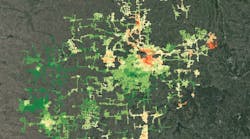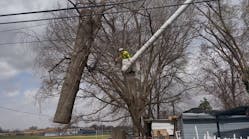Harness the Power of Data Science to Streamline Vegetation Management
Managing vegetation and tree growth around power lines is an important responsibility that rests on the shoulders (and budgets) of utilities. It plays a critical role in fire hazard mitigation and ensures the reliability of the grid, but it’s a costly process that can be greatly improved with modern, data-driven optimizations.
Historically, utilities have approached vegetation management using a cyclical, time-based approach—inspecting and trimming the areas around their lines on a five- or seven-year cadence. This decades-old method requires a lot of boots on the ground and has worked well enough, but a lack of meaningful data and computing power left utilities with few options for addressing inefficiencies in the process.
Now, thanks to advances in predictive data science, there are new opportunities to improve utilities’ vegetation-management operations. After all, Thomas Edison’s grid served the industry well for over 100 years, but utilities are now improving it with advances in smart grid and distributed technology. The same idea can be applied to vegetation management: new developments in technology and data science warrant a reevaluation of existing processes to achieve operational efficiencies and cost savings.
Applying Predictive Data Science to Vegetation Management
Utilities that are pursuing operational enhancements to their vegetation-management process can benefit from seeking granularity at the transmission level. E Source is helping utilities take things all the way down the polygon scale with the new vegetation-management solution. One of the solutions under the E Source GridInform product line provides a “view from above” that represents individual trees mapped onto the grid using LiDAR scans where available and then builds on top of that with satellite imagery and other data sources to create a complete digital simulation of the grid.
LiDAR generates an enormous amount of data, and it’s cheaper than sending trucks out to get a current-state assessment of vegetation in a specific area, but it doesn’t help answer questions like, “How do I change my process to adapt to this data?” unless you use predictive data science.
By applying methodologies from environmental science, forestry, statistics and computer science and combining them with historical data on outage records, asset types, maintenance and inspection records—along with the LiDAR data—GridInform can run it through artificial intelligence (AI) models to calculate a vegetation risk score. Utilities then use that risk score to identify areas to focus on and improve operating efficiency, resulting in reduced operating costs while maintaining reliability.
The resulting datasets and risk scores can also be plugged into scenario-planning models to help budget planners forecast the effects of things like spraying a certain herbicide or deferring the removal of hazard trees in certain areas—true “what if” scenario evaluations.
Analyzing Tree Growth at the Distribution Level
This same approach can also be applied on the distribution system, but with some adjustments. On the distribution system, you’re dealing with 10 times as many line miles and outages that happen at a much more frequent pace. And you don’t always know exactly where they happen. You might know they happened downstream of a particular device because that device saw an outage, but you don’t know what span it happened on. So rather than focusing on LiDAR (which is typically cost-prohibitive for distribution) and specific tree polygons, GridInform segments the entire service territory into small 500-by-500-m grids, also called cells. This allows the risk to be granular and precise without being thrown off by some of the natural noise that occurs in the data.
Using a variety of utility data (such as historic outages, asset information, and tree-trimming history) and external data (such as weather, terrain, and satellite images), E Source GridInform calculates the risk of vegetation outages across the entire service territory, so the utility can focus its vegetation-management plan on the areas with the best return on investment in terms of improved safety and reliability.
Helping Utilities Across the U.S. with GridInform
Admittedly, there has been a lot of hype around the savings that vegetation data or condition-based trimming can offer. Back in the day, this was called “just-in-time” trimming, and only the most severe vegetation was addressed. As an industry, we all know that this method allows you to do less work in the short term, but that eventually it will cost you in the long term as you fall behind and the vegetation doesn’t stop growing.
With GridInform, it isn’t about magically doing less work and seeing more reliability. It’s about doing the right work and optimizing the overall planning to get the most bang for your buck with every vegetation-management decision. Yes, you’ll be doing less work on low-risk areas, but you’ll also be likely doing more work on the areas of higher risk, where you can get more improvement in reliability per dollar spent.
GridInform typically saves utilities 10% to 20%, with no negative effects on safety or reliability. Some utilities choose to bank that savings in terms of decreased operations and maintenance (O&M) spend; others reinvest the savings into the system by doing off-cycle trimming of the data-driven high-risk areas to hold their overall budget steady while improving the safety and reliability of the system.
Additionally, the E Source data science approach will help reduce the amount you spend on expensive data-collection methods such as LiDAR. For example, one client fully funded its data science–based optimizations with the money it saved on LiDAR scans.
Using GridInform, another client now predicts and resolves issues before they cause a service interruption. This client reported that 2020 was its best year yet for tree-related interruptions as measured by the system average interruption frequency index (SAIFI), even though the territory had a significant increase in bad weather events during the year.
A third client was planning to do midcycle tree-trimming work when the E Source analysis revealed that 28% of the predicted outage duration was being created by only 4% of the utility’s high-risk areas. By targeting only the highest-risk areas, the client optimized vegetation management, reducing its targeted trim miles by almost 80%—from 800 to 180 circuit miles—while simultaneously improving overall grid reliability.
Operational wins aren’t the only benefit of GridInform. Clients have also used the data science approach to create storm-normalized outage results as a way to track, measure, and explain to regulators the value of their vegetation-management program without being tied to the normal variability of annual changes in weather intensity.
Using Data Science to Optimize and Streamline
With the power of data science on their side, utilities are optimizing and streamlining their vegetation-management operations. E Source has used data science techniques to calculate vegetation risk scores across its clients’ transmission lines, allowing them to cut costs, improve system reliability, and optimize crew work plans and schedules.
Visit the E Source website for more information on its data science solutions.


